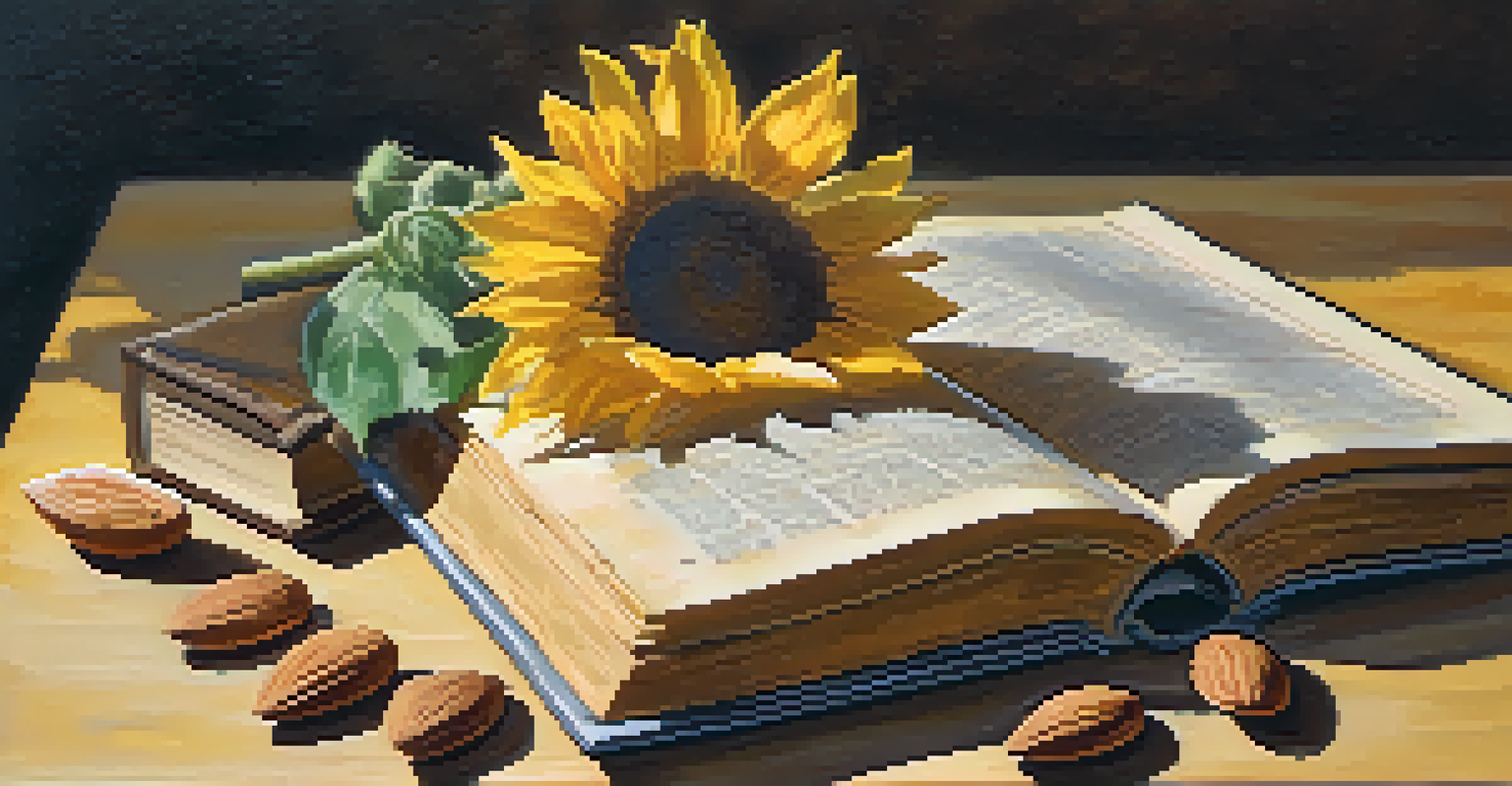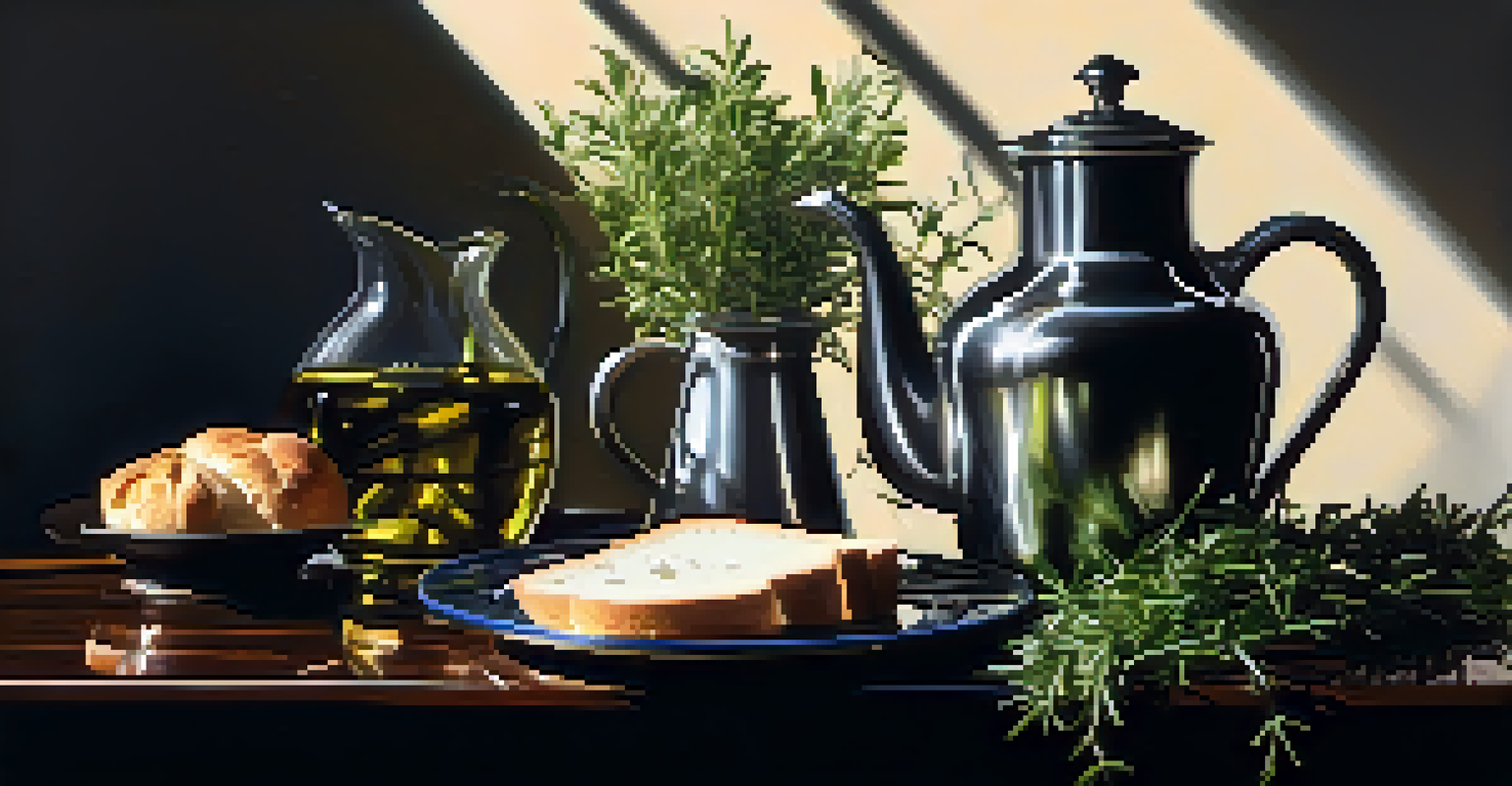From Nature to Table: The Inspiration Behind Still Life

Understanding Still Life: A Timeless Artistic Genre
Still life is a captivating artistic genre that focuses on inanimate objects, often arranged with great care. This genre has roots tracing back to ancient times, but it truly blossomed during the Renaissance. Artists embraced the opportunity to showcase everything from fruits and flowers to everyday items, turning the mundane into something extraordinary.
Still life is a way of showing the beauty in ordinary things.
At its core, still life invites viewers to appreciate the beauty and details of the world around them. Each element in a composition serves a purpose, contributing to the overall harmony and message of the artwork. This attention to detail often reflects the artist's personal experiences and the environment they inhabit, offering a glimpse into their world.
Moreover, still life is not just about representation; it’s also about storytelling. Each object can symbolize deeper meanings, whether it’s the fleeting nature of life through wilting flowers or abundance through a cornucopia of fruits. This narrative layer adds depth, inviting the audience to engage with the piece on a more intimate level.
The Historical Journey of Still Life Art
The history of still life art is rich and varied, with different cultures interpreting the genre in unique ways. In ancient Egypt, artists created detailed depictions of food and offerings, while the Dutch Golden Age saw a flourishing of still life paintings filled with symbolic meanings. These works often celebrated wealth and the joys of life, showcasing vibrant colors and intricate details.

During the Baroque period, still life took on a more dramatic tone, with contrasting light and shadow highlighting the textures of various objects. This technique, known as chiaroscuro, enhanced the visual impact and emotional depth of the paintings. Artists like Caravaggio and his followers became renowned for their skill in this area, leaving a lasting influence on the genre.
Still Life: A Rich Artistic Genre
Still life art invites viewers to appreciate the beauty of inanimate objects while offering deeper meanings and narratives.
In more modern times, still life has evolved and adapted to reflect contemporary themes and societal changes. Artists now experiment with different materials and styles, merging traditional techniques with modern concepts. This evolution demonstrates the genre's versatility, allowing it to remain relevant and engaging for today's audiences.
Nature's Influence: The Role of Organic Elements
Nature is a profound source of inspiration for still life artists, often serving as the focal point of their compositions. The vibrant colors, diverse textures, and intricate forms of flowers, fruits, and vegetables create a sensory experience that captivates both the artist and the viewer. These organic elements not only add visual interest but also evoke emotions and memories related to nature.
Every object has a story to tell; it’s up to the artist to tell it.
Incorporating natural elements into still life art allows for a celebration of the seasons and the passage of time. For instance, a bouquet of fresh spring flowers might symbolize rebirth and renewal, while a bowl of autumn fruits can represent harvest and gratitude. This connection to nature enriches the narrative and invites the audience to reflect on their own experiences with the natural world.
Furthermore, many artists emphasize sustainability and ecological awareness through their still life works. By showcasing locally sourced or seasonal produce, they encourage viewers to appreciate the beauty of nature and the importance of protecting it. This thoughtful approach not only elevates the art but also fosters a deeper connection with the environment.
Symbolism in Still Life: Objects with Meaning
One of the most intriguing aspects of still life art is the use of symbolism within the objects depicted. Artists often choose specific items to convey messages or themes, creating layers of meaning that can resonate with viewers. For example, a skull might signify mortality, while a blooming flower can represent the beauty of life, intertwining joy and sorrow.
The choice of objects is deliberate and reflects the artist's intent. A simple loaf of bread might symbolize sustenance and community, while a wilting flower may evoke the transient nature of beauty. By carefully selecting each element, artists craft a narrative that encourages viewers to ponder the deeper implications behind the artwork.
Symbolism Enhances Interpretation
The careful selection of objects in still life art creates layers of symbolism, allowing for personal interpretations and connections.
This rich tapestry of symbolism makes still life art particularly engaging, inviting the audience to interpret and connect with the work. Each viewer may derive different meanings based on their personal experiences, which adds to the allure of the genre. It transforms a seemingly simple arrangement into a profound exploration of life’s complexities.
Techniques and Approaches in Creating Still Life
Creating a still life involves a combination of artistic skill and thoughtful planning. Artists typically start with a concept or theme, selecting objects that align with their vision. This initial selection process is crucial, as it sets the tone and direction for the entire piece.
Once the objects are chosen, artists arrange them in a way that highlights their unique qualities. Composition is key in still life; the placement of each item can lead the viewer’s eye through the artwork. Techniques like layering, balancing colors, and adjusting light angles are often employed to create a visually striking arrangement.
Finally, artists use various painting techniques to bring their still life to life. Whether through oil paints, watercolors, or mixed media, the choice of material affects the texture and feel of the final work. Each brushstroke adds to the narrative, transforming simple objects into a captivating visual story that resonates with the audience.
Modern Interpretations: Still Life in Contemporary Art
In recent years, still life has undergone a renaissance of its own in contemporary art circles. Modern artists are reimagining the genre, experimenting with unconventional materials and techniques. This fresh perspective challenges traditional notions, expanding the boundaries of what still life can represent.
Contemporary still life can incorporate elements like photography, digital art, and installation pieces, allowing for greater expression and innovation. Artists may juxtapose everyday objects with surreal elements, creating a dialogue about consumerism, identity, and the environment. This blend of the familiar and the unexpected keeps the genre vibrant and relevant.
Modern Takes on a Classic Form
Contemporary artists are redefining still life by incorporating new materials and themes, keeping the genre fresh and relevant.
Additionally, the rise of social media has given artists a platform to share their works instantly, reaching a broader audience. The accessibility of platforms like Instagram allows for a new appreciation of still life art, as creators engage with viewers in real time. This interaction fosters a community around the genre, encouraging collaboration and inspiration among artists.
The Enduring Allure of Still Life: A Reflection
The enduring appeal of still life lies in its ability to invite contemplation and reflection. In a world that often rushes by, these artworks encourage us to pause and appreciate the beauty found in everyday objects. They remind us that art can be found in the simplest of things, transforming our perspective on the world around us.
Furthermore, still life art has a unique capacity to evoke nostalgia and personal memories. Viewers may find themselves reminiscing about family gatherings, meals shared, or moments spent in nature. This emotional connection creates a bond between the artwork and its audience, making each piece resonate on a personal level.

Ultimately, still life serves as a reminder of the richness of life and the stories woven into the fabric of our surroundings. As artists continue to explore and redefine this genre, still life will undoubtedly remain a source of inspiration and reflection for generations to come.